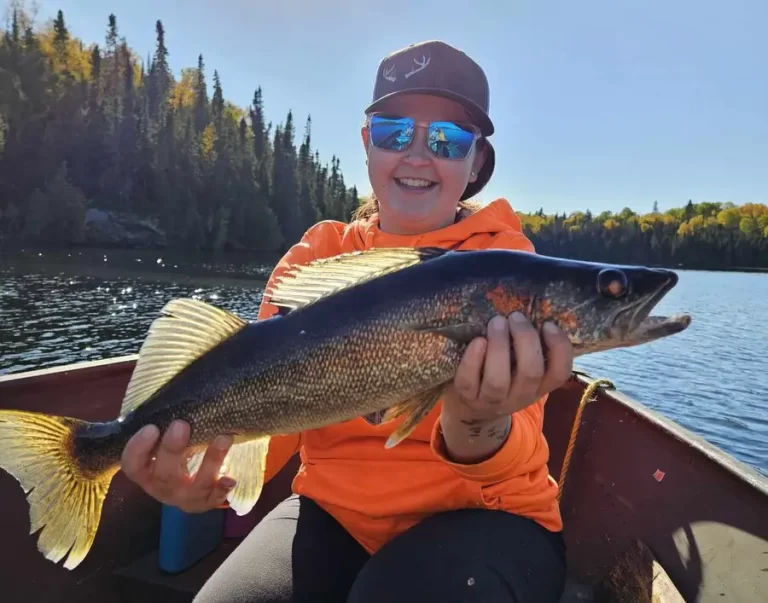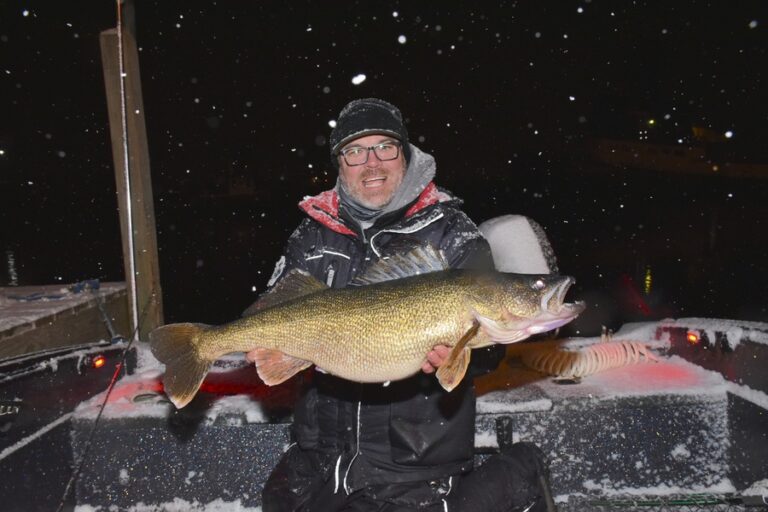What Size is a Trophy Walleye? (Catch a State Record Fish)
A walleye is generally considered “big” when it reaches about 8 pounds or measures over 25 inches. It’s typically deemed a “trophy” at a weight of 10+ pounds and 30 inches in length.
In the United States, a walleye over 8 pounds is considered big and a walleye over 10 pounds is considered a trophy. In Canada where walleye live longer and grow larger, a walleye over 12 pounds is considered a trophy.
I’ve worked multiple fisheries jobs associated with walleye fisheries management. As a seasonal fisheries technician for a western state, I got to interview anglers lakeside and find out how big the walleye were they were catching. It was very interesting to learn what each angler at each body of water thought was and was not a big walleye.

Table of Contents
What Size is a Trophy Walleye
A trophy-sized walleye typically refers to an exceptionally large specimen, often weighing at least 10 pounds and measuring 30 inches or more in length.
These impressive sizes are usually a result of the fish’s age, with many being several years old, and are influenced by factors such as:
- walleye genetics
- abundances and size of prey
- easiness of prey available. Ex: Shad with their soft fins are easier prey to eat than a yellow perch with sharp rigid spines and sharp gill covers.
- environmental conditions to include water clarity and water depth.
- availability of suitable structure and deep weed edges.
The criteria for what defines a trophy walleye can vary regionally, influenced by local walleye population characteristics and angler perceptions. Catching a trophy walleye is a notable achievement in the angling community, symbolizing both the angler’s skill and the quality of the walleye population.
My personal best walleye was a 12 pounder I caught on a fishing charter in Lake Erie. It may as well have been a 20 pounder in my mind because of how proud I was in that fish.
Factors Influencing Walleye Size
Environmental Factors Impacting Walleye Growth
- Water Temperature: Walleye growth rates are significantly influenced by water temperature. Optimal temperatures promote faster growth, while extreme temperatures can stunt it.
- Food Availability: Abundant forage, especially smaller fish like minnows and shad, directly correlates with larger walleye sizes. Yellow perch are another big walleye producer.
- Water Quality and Habitat: Clean water with ample oxygen and suitable habitats, such as a mix of deep and shallow areas, supports healthier and larger walleye populations.
- Fishing Pressure: Heavily fished areas can lead to smaller average sizes due to the removal of larger, breeding-size fish from the population.
The Role of Genetics in Walleye Size
- Inherent Genetic Traits: Just like other species, walleyes have genetic predispositions that determine their potential size. Some populations are naturally inclined to grow larger due to their genetic makeup.
- Selective Breeding in Stocked Waters: In waters where walleye are stocked, fishery management practices, including selective breeding, can influence the average size of the walleye population.
- Local Adaptations: Different walleye populations may adapt genetically to their specific environments, which can influence their growth patterns and ultimate size. For example, walleye in northern lakes may have evolved to grow larger due to longer lifespans and different foraging opportunities compared to their southern counterparts.
For a complete breakdown of the best walleye sizes to get mounted.
Known Big Walleye Producing Lakes/Rivers
- Famous Walleye Lakes:
- Lake Erie: Part of the Great Lakes, known for producing numerous trophy-sized walleye.
- Lake of the Woods, Minnesota/Ontario: This massive lake offers excellent opportunities for large walleye, especially near the Rainy River inlet.
- Lake Winnipeg, Manitoba: Famous for its “Greenback” walleye, which often reach trophy sizes.
- Notable Rivers:
- Columbia River, Washington/Oregon: Known for big walleye, especially in the McNary Dam area.
- Missouri River System: Offers excellent walleye fishing, with many stretches known for large fish.
- Reservoirs with Record Walleyes:
- Fort Peck Reservoir, Montana: A consistent producer of large walleye.
- Lake Sakakawea, North Dakota: This reservoir has yielded many trophy walleye catches.
Comparing Size Variations Across Different Water Bodies
- Rivers vs. Lakes:
- Rivers like the Columbia and Missouri tend to produce larger, but fewer, walleye compared to lakes. River walleyes are often more muscular and robust due to the current.
- Lakes, especially the Great Lakes and large northern lakes like Lake of the Woods and Lake Erie, are known for their high population density of walleye, increasing the chance of catching big fish.
- Reservoirs:
- Reservoirs offer a unique habitat with fluctuating water levels, which can impact walleye growth. However, reservoirs like Fort Peck and Lake Sakakawea have become renowned for producing large walleye due to abundant forage and suitable habitat conditions.
- Great Lakes:
- The Great Lakes, particularly Lake Erie, stand out for their walleye fishing. The vast size, combined with excellent forage availability, creates ideal conditions for walleye to grow to trophy sizes.
Tips for Catching a State Record or World Record Walleye
- Research and Record Analysis: Start with a deep dive into past record catches. Identify patterns like locations, times of year, and conditions under which previous records were set.
- Target Prime Locations: Focus on waters known for producing large walleyes. Lakes and rivers with a history of record catches should be your playground. It’s like searching for treasure where X marks the spot. This is my most important tip. Go where very big walleye are known to be. This will be your very best step towards catching a record-caliber fish.
- Seasonal Strategies: Align your fishing trips with peak seasons for big walleyes. Spring and fall are often prime times, with spawning and pre-winter feeding leading to increased activity.
- Advanced Scouting Techniques: Utilize technology like sonar and GPS mapping to identify underwater structures, drop-offs, and walleye hideouts. It’s like having a treasure map and X-ray vision rolled into one.
- Specialized Gear and Tackle: Invest in high-quality rods, reels, and line suited for battling trophy-sized walleye. Think of it as arming yourself for an epic duel with a water warrior.
- Expert Bait and Lure Selection: Use a variety of baits and lures known to attract larger walleye. Experiment with live bait, crankbaits, and jigs to find your magic formula.
- Night Fishing Adventures: Big walleyes are often more active at night. Venture out after dark with appropriate gear and techniques for a thrilling nocturnal quest.
- Hiring a Guide: Sometimes, the wisdom of a local expert can make all the difference. A seasoned guide can offer invaluable insights and lead you to hotspots.
- Persistence and Patience: Record catches don’t happen overnight. Stay persistent, keep refining your techniques, and embrace each trip as a new adventure.
- Document Your Efforts: Keep a detailed fishing log. Documenting conditions, tactics, and near-successes can provide crucial clues for your quest.
- Prime Times to Fish:
- Early Morning & Late Evening: Target the twilight hours. Walleye are most active during low light conditions, making dawn and dusk prime times.
- Night Fishing: Big walleye are often nocturnal feeders. Fishing after dark can increase your chances of hooking a giant.
- Seasonal Peaks: Spring (pre and post-spawn) and fall (pre-winter feeding frenzy) are often the best times to catch large walleyes.
- Best Baits and Sizes:
- Live Bait: Large minnows, leeches, and nightcrawlers are excellent choices. The bigger the bait, the more likely you’ll attract a trophy walleye.
- Artificial Lures: Large crankbaits, spinnerbaits, and jigs. Choose lures that mimic natural prey in size and appearance.
- Specialty Baits: Soft plastics that imitate baitfish, and swimbaits can be effective, especially when fished near the bottom.
- Best Spots on a Lake or River:
- Drop-offs and Ledges: Walleye often patrol these areas for prey.
- Underwater Structures: Focus on sunken trees, submerged boulders, and weed beds.
- River Mouths and Inlets: Where tributaries meet larger bodies of water, food and oxygen are plentiful, attracting big walleye.
- Deep Holes: Especially in rivers, walleye might congregate in deeper pools.
- Advanced Techniques:
- Trolling: Use planer boards and downriggers to cover more water and reach different depths.
- Jigging: A vertical jigging approach can be highly effective, especially near structures.
- Casting: Cast near shorelines during spawning season and in deeper waters during summer.
State & Provincial Records for Walleye
To the best of my research, these are the biggest walleye caught in the following states and provinces.
United States:
- Minnesota: 17 lbs, 8 oz – Seagull River at Saganaga Lake
- Wisconsin: 18 lbs – High Lake, Vilas County
- Michigan: 17 lbs, 3 oz – Pine River
- Ohio: 16 lbs, 2 oz – Lake Erie
- Pennsylvania: 17 lbs, 9 oz – Allegheny Reservoir
- New York: 16 lbs, 7 oz – Mystic Lake
- North Dakota: 15 lbs, 13 oz – Wood Lake
- South Dakota: 16 lbs, 2 oz – Horseshoe Lake
- Montana: 17 lbs, 8 oz – Tiber Reservoir
- Colorado: 18 lbs, 13 oz – Standley Lake
- Maine: 10 lbs – Messalonskee Lake
- Tennessee: 25 lbs – Old Hickory Lake
Canada:
- Ontario: 22 lbs, 4 oz – Niagara River
- Quebec: 18.2 lbs. – Saint-Lawrence River
- Manitoba: 39.6 lbs (Greenback Walleye) – Lake Winnipeg
- Saskatchewan: 18.3 lbs – Tobin Lake
- Alberta: 15 lbs, 8 oz – Oldman River Reservoir
Frequently Asked Questions
Minimum Weight for a Trophy Walleye
A walleye is typically considered a trophy when it weighs at least 10 pounds. However, this can vary by region, with some areas setting higher weight thresholds based on local fish populations.
Length Criteria for Trophy Walleye
To qualify as trophy-sized, a walleye generally measures 30 inches or longer. This length indicates a mature, well-developed fish and is a widely accepted benchmark among anglers.
Regional Variations in Trophy Walleye Definition
The definition of a trophy walleye does vary by region. In areas where walleye grow larger, such as the Great Lakes, the criteria for trophy size might be higher compared to other regions.
Age Characteristics of Trophy Walleye
Trophy walleye are often older fish, usually several years old, as age plays a significant role in their growth and size. These walleyes have had more time to feed and mature, reaching sizes that qualify them as trophies.
How does genetics impact walleye sizes?
Genetics are a crucial factor in determining the potential size of a walleye. Certain genetic traits can predispose walleye populations to grow larger, contributing to their trophy status.
How does fishing pressure impact walleye sizes in a body of water?
High fishing pressure can affect the size of walleye populations, often leading to a decrease in the average and trophy sizes. Overfishing, especially of larger, breeding individuals, can reduce the chances of encountering trophy-sized fish.
Is skill or luck responsible for trophy walleye?
Catching a trophy walleye involves both skill and luck. Skill in understanding walleye behavior, habitat, and effective fishing techniques is essential, but luck also plays a role due to the elusive nature of these large fish.






